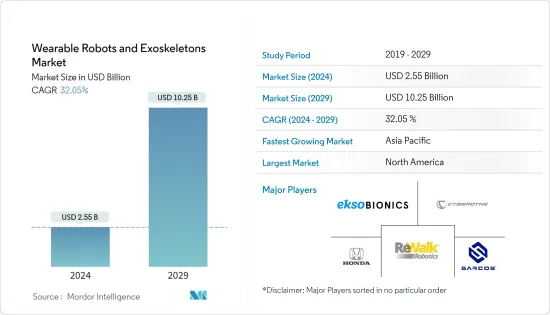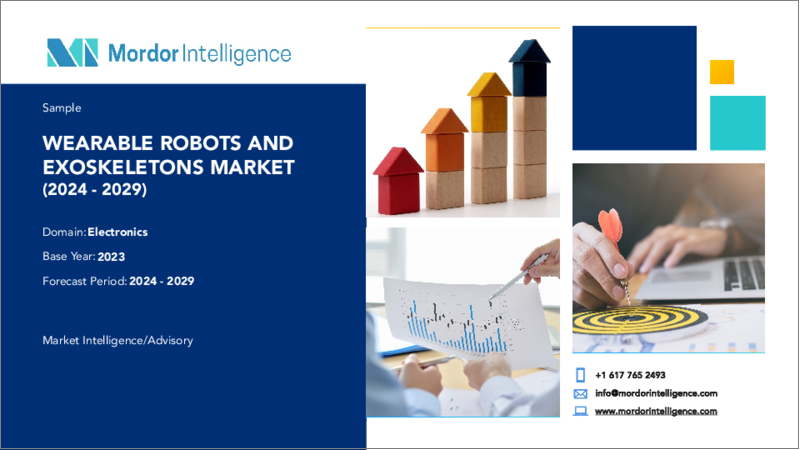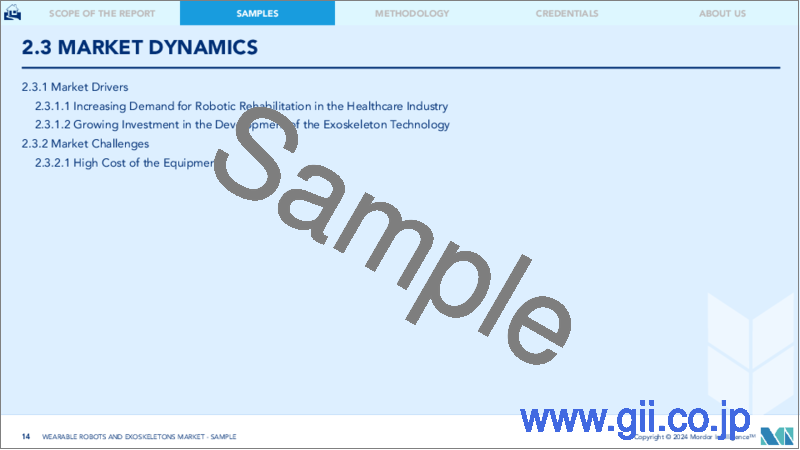|
|
市場調査レポート
商品コード
1438479
ウェアラブルロボットおよび外骨格:市場シェア分析、業界動向と統計、成長予測(2024~2029年)Wearable Robots and Exoskeletons - Market Share Analysis, Industry Trends & Statistics, Growth Forecasts (2024 - 2029) |
||||||
|
● お客様のご希望に応じて、既存データの加工や未掲載情報(例:国別セグメント)の追加などの対応が可能です。 詳細はお問い合わせください。 |
|||||||
| ウェアラブルロボットおよび外骨格:市場シェア分析、業界動向と統計、成長予測(2024~2029年) |
|
出版日: 2024年02月15日
発行: Mordor Intelligence
ページ情報: 英文 120 Pages
納期: 2~3営業日
|
- 全表示
- 概要
- 目次
ウェアラブルロボットおよび外骨格の市場規模は、2024年に25億5,000万米ドルと推定され、2029年までに102億5,000万米ドルに達すると予測されており、予測期間(2024年から2029年)中に32.05%のCAGRで成長します。

新型コロナウイルス感染症(COVID-19)のパンデミックの出現により、これまでにさまざまな地域で実施されたロックダウン措置により、ロボットサプライヤーは短期間、完全に停止状態に陥った。しかしその一方で、パンデミックは、臨床医や業界パートナーと協力し、進化する医療サービスに対応して、主に実際の臨床課題に焦点を当てて対処することで、製品やサービスのプロバイダーが市場での存在感を高める生産的な業界の機会も生み出しました。患者のニーズ。
主なハイライト
- ウェアラブルロボットまたは外骨格は開発の初期段階にあり、これらのウェアラブル外骨格は個人の移動を支援し、人体に装着して制御できるため、ヘルスケア、産業、軍事、防衛などのさまざまな業界で最大限の採用を示すために継続的に進化しています。そして人の動きを補助します。
- ヘルスケア分野では、外骨格は、脳卒中患者や麻痺した人々の直立歩行を補助および促進し、失われた機能を再学習することで、患者の回復を助けています。 Maxon Motor AGの調査によると、世界中で毎日約1億8,500万人が車椅子を使用していると同社は推定しています。
- たとえば、Ekso GTはEsko Bionicsの外骨格で、包括的な歩行療法ツールとして設計されたウェアラブル外骨格であり、患者とセラピストに比類のないリハビリテーション体験を提供します。さらに、テクノロジーの発展により、フランスでは麻痺のある男性がマインドコントロールされた外骨格を使って歩き始めました。
- 業界のさまざまな企業がすでに外骨格の製造能力をテストし、導入する準備ができており、将来的には市場がさらに拡大する可能性があります。たとえば、自動車メーカーのフォードは、世界中の15の組立工場に外骨格を配備することを計画し、EksoVestを採用しました。この外骨格は、繰り返し頭上作業を行う作業者の腕を持ち上げてサポートします。 EksoVestの導入により、試用期間中に職場での負傷が83%減少しました。
- 個人の移動を支援する外骨格に対する需要も高まっています。パーキンソン病や脳卒中などの身体運動障害を患う患者数の増加は、外骨格の需要を加速させる主要因となっています。これらの病気は自発的な身体運動を制限し、日常生活活動に問題を引き起こすからです。たとえば、パーキンソン病財団の推計によると、米国のパーキンソン病患者の数は2020年に約93万人になる可能性があり、2030年までに120万人に達すると予想されています。
ウェアラブルロボットおよび外骨格の市場動向
ヘルスケアが大きなシェアを占めると予想される
- 外骨格は、理学療法から救急サービスに至るまで、医療業界での応用が増えています。たとえば、デリーを拠点とする新興企業GenElek Technologiesは、脳卒中、麻痺、脊髄損傷(SCI)、またはその他の神経学的症状に苦しむ人々を支援するロボット支援システムを提供しています。外骨格は障害者が再び歩くのを助けます。それは彼らの自立と自立を助け、肉体的にも精神的にも利益をもたらします。上述のこれらの進歩は、ヘルスケア市場を牽引すると予想されます。
- インドリハビリテーション評議会の報告書によると、インドでは毎年、15,000人以上が脊髄損傷または脳卒中により歩行能力を失っており、これは毎年100万人あたり15人の新規感染者がいることに相当し、地元企業は、人間の大脳辺縁系の能力を強化する、体外に装着されるロボットおよび外骨格サポートシステムを提供します。
- さらに、市場の多くのプレーヤーは、ヘルスケア業界の人々のために製品を革新し、必要な承認を得ようと常に努力しています。たとえば、下肢障害のある人向けのロボット医療機器のメーカーであるReWalk Roboticsは、米国食品医薬品局が同社のReStoreソフト外骨格スーツシステムを米国のリハビリテーションセンターに販売することを許可したと発表しました。
- さらに、小規模な企業もいくつか登場しています。たとえば、日本に拠点を置くArchelis Inc.は、日本語の「歩きやすい椅子」に由来するArchelisFX外骨格を展示しました。このデバイスは、腰痛や最近手術を受けた人など、いくつかのシナリオを想定して設計されています。同社は、約5,000ドルでレンタルまたは購入できると述べた。
- 2021年 1月、カリフォルニアに本拠を置く外骨格技術のイノベーターであるsuitXは、新しいウェアラブル外骨格 ShieldXの発売を発表しました。分厚い抗放射線エプロンの着用が義務付けられているヘルスケア従事者向けに作られています。 ShieldXは、ユーザーの肩や背骨にかかる重い抗放射線エプロンの重量を100%軽減します。 ShieldXは、キャリアを短縮し、仕事以外の活動を制限するこれらの重いエプロンに関連する首と背中の怪我を減らすことを目指しています。
アジア太平洋地域が最大の市場シェアを占めると予想される
- アジア太平洋はウェアラブルロボット技術の研究開発のリーダーです。特に韓国と日本は市場の研究開発をリードしています。たとえば、韓国機械材料研究院の韓国調査チームは2021年4月、配送から建設作業までさまざまな物理的な作業に使用できるスーツ型ウェアラブルデバイスであるウェアラブルロボット技術を開発しました。腕、太ももなどの体の部位に貼り付けて筋肉をサポートします。
- 韓国は常にロボット工学とオートメーション技術の製造の中心地でした。研究開発への注力と革新的な技術への政府支出は、この国のウェアラブルロボット工学の進歩の重要な要因でした。この国の民間部門も、ウェアラブルロボットや外骨格に関連する技術や応用範囲を積極的に拡大しています。
- たとえば、サムスン電子は2021年 6月に、2021年末までにヘルスケア用のウェアラブルロボットを商品化すると発表しました。この韓国のテクノロジー大手は、主要な成長原動力の1つとしてロボット分野に参入しています。同社によれば、立ち上がること、歩くこと、走ることが困難なユーザーを支援し、フィットネス機器としても利用できるウェアラブルロボットの導入を計画しているといいます。このウェアラブルロボットの価格は500万ウォンから1,000万ウォンの間になると予想されているが、同社はより手頃な価格にするために価格を引き下げる可能性があります。
- ウェアラブルロボットや外骨格市場のプレーヤーは、アジア太平洋地域への投資を増やしています。たとえば、2021年 4月、香港に拠点を置く外骨格市場の業界リーダーであるEkso Bionicsは、オーストラリアのロイヤルリハビリテーションとの提携を発表し、同社のロボット外骨格の使用をアジア太平洋全体にさらに拡大しました。
- この地域の軍隊も軍隊用の外骨格ロボットを開発しています。たとえば、台湾は2021年10月に、兵士の身体的持久力を向上させ、さまざまな軍事作戦での機動性を高めることができる電池式外骨格スーツの第一世代を発売しました。
ウェアラブルロボットおよび外骨格業界の概要
ウェアラブルロボットおよび外骨格市場は、Cyberdyne Inc.、ReWalk Robotics Inc.、Ekso Bionics Holdings Inc.などの大手プレーヤーの存在により、本質的に競争が激しいです。さらに、市場の可能性により多くのスタートアップ企業が市場に投資しており、競合が激化しています。多くの企業は、新製品の導入、事業の拡大、または戦略的な合併・買収によって市場での存在感を高めています。
- 2021年7月サイバーダイン株式会社は、株式会社ジェイ・ワークアウト(東京都江東区、代表取締役社長:伊佐卓則、以下「ジェイ・ワークアウト」)と業務提携し、2021年8月より下記の新サービスを提供いたします。 Neuro HALFITは、ウェアラブルサイボーグHALにより脳神経系の活動ループを活性化することで、運動機能が低下した人の機能改善を促進するサービスです。
- 2021年 3月-Ekso Bionicsは、EksoNR外骨格の臨床的利点について医師を教育するために米国の理学療法士との提携を発表しました。このパートナーシップは、医師や他のリハビリテーション療法士の間でEkso Bionicsテクノロジーの認識を高め、ロボット工学をリハビリテーションプログラムにうまく組み込む方法を教えるのに役立ちます。
その他の特典
- エクセル形式の市場予測(ME)シート
- 3か月のアナリストサポート
目次
第1章 イントロダクション
- 調査の前提条件と市場の定義
- 調査範囲
第2章 調査手法
第3章 エグゼクティブサマリー
第4章 市場洞察
- 市場概要
- 業界の魅力- ポーターのファイブフォース分析
- 新規参入業者の脅威
- 買い手の交渉力
- 供給企業の交渉力
- 身代わりの脅威
- 競争企業間の敵対関係の激しさ
- COVID-19感染症による業界への影響の評価
第5章 市場力学
- 市場促進要因
- ヘルスケア業界におけるロボットリハビリテーションの需要の増加
- 外骨格技術の開発への投資の拡大
- 市場抑制要因
- 機器のコストが高い
第6章 市場セグメンテーション
- タイプ別
- パワード外骨格
- パッシブ外骨格
- エンドユーザー産業別
- ヘルスケア
- 軍事と防衛
- 産業
- その他のエンドユーザー産業
- 地域別
- 北米
- 欧州
- アジア太平洋地域
- 世界のその他の地域
第7章 競合情勢
- 企業プロファイル
- Cyberdyne Inc.
- ReWalk Robotics Inc.
- Ekso Bionics Holdings Inc.
- Sarcos Corporation
- Honda Motor Co. Ltd.
- Hocoma AG(DIH International Ltd.)
- Lockheed Martin Corporation
- Technaid. SL
- Skelex
- ATOUN Inc.
第8章 投資分析
第9章 市場の将来
The Wearable Robots and Exoskeletons Market size is estimated at USD 2.55 billion in 2024, and is expected to reach USD 10.25 billion by 2029, growing at a CAGR of 32.05% during the forecast period (2024-2029).

Due to the emergence of the COVID-19 pandemic, the previously put lockdown measures across various regions significantly brought the robotic suppliers to a complete standstill for a short period. However, on the other hand, the pandemic has also created productive industry opportunities for the products and service providers to increase their presence in the market by primarily focusing on and addressing real clinical challenges in collaboration with clinicians and industry partners and in response to the evolving patients' needs.
Key Highlights
- The wearable robots or exoskeletons are in their nascent stage of development and continuously evolving to exhibit maximum adoption in various industries, like healthcare, industrial, military, and defense, as these wearable exoskeletons assist personal mobility and can be worn on the human body and control and assists the movements of the person.
- In the healthcare sector, exoskeletons are helping patients' recovery by assisting and encouraging upright walking and relearning lost functions for stroke patients and people who are paralyzed. According to a study by Maxon Motor AG, the company estimated that approximately 185 million people use a wheelchair daily worldwide.
- For instance, Ekso GT is an exoskeleton by Esko Bionics, which is a wearable exoskeleton engineered as a comprehensive gait therapy tool and provides an unparalleled rehabilitation experience for patients and therapists. Additionally, due to technological developments in technology, a paralyzed man started walking using a mind-controlled exoskeleton in France.
- Various companies in the industry have already tested exoskeletons for their manufacturing capabilities and are ready to deploy them, which is likely to augment the market in the future further. For instance, automobile manufacturer, Ford, planned to deploy exoskeletons in fifteen assembly plants worldwide and adopted the EksoVest. This exoskeleton elevates and supports the arms of workers performing repeated overhead tasks. The adoption of EksoVests reduced workplace injuries by 83% during the trial period.
- There is also an increasing demand for exoskeletons to assist in personal mobility. An increasing number of patients with body movement disorders, such as Parkinson's disease, strokes, etc., are the prime factors accelerating the exoskeleton demand, as these diseases limit voluntary body movements and create problems in daily routine activities. For instance, according to the Parkinson's Foundation estimates, the number of people in the United States with Parkinson's disease may be around 930,000 in 2020, and it is expected to reach 1,200,000 by 2030.
Wearable Robots & Exoskeletons Market Trends
Healthcare is Expected to Hold a Significant Share
- Exoskeletons have increasing applications in medical industries ranging from physiotherapy to emergency services. For example, GenElek Technologies, a Delhi-based startup, provides a robotic support system that aids people suffering from stroke, paralysis, spinal cord injury (SCI), or other neurological conditions. The exoskeleton assists disabled people in walking again. It will help them become self-reliant and independent, which will benefit them physically and mentally. These advancements mentioned above are expected to drive the healthcare market.
- According to a report of the Rehabilitation Council of India, every year, more than 15,000 people lose their ability to walk either due to a spinal injury or stroke in India, which translates to 15 new cases per million every year, which provides an opportunity for local companies to provide an externally worn robotic and exoskeleton support system that enhances a human's limbic capabilities.
- Further, many players in the market are constantly trying to innovate products for people in the Healthcare industry and get the necessary approval. For instance, ReWalk Robotics, a manufacturer of robotic medical devices for individuals with lower limb disabilities, announced that the US Food and Drug Administration had cleared its ReStore soft exo-suit system for sale to rehabilitation centers across the United States.
- Moreover, some smaller companies have also emerged. For instance, Japan-based Archelis Inc. showcased the ArchelisFX exoskeleton, which derives from the Japanese word for "walkable chair." The device is designed for several scenarios, including back pain and recently undergoing surgery. The company said it would be available to rent or buy for around USD 5,000.
- In January 2021, suitX, a California-based innovator in exoskeleton technologies, announced the launch of a novel wearable exoskeleton, shieldX. It is made for the healthcare personnel required to wear heavy anti-radiation aprons. ShieldX removes 100% of the weight of a heavy anti-radiation apron from the user's shoulders and spine. ShieldX aims to reduce neck and back injuries linked to these heavy aprons shortening careers and limiting activities outside of work.
Asia Pacific is Expected to Account for the Largest Market Share
- Asia-Pacific is the leader in the R&D of wearable robot technology. South Korea and Japan are specifically leading in the R&D of the market. For instance, in April 2021, a South Korean research team from the Korea Institute of Machinery and Materials developed a wearable robot technology, a suit-type wearable device, that can be used for a variety of physical tasks from delivery to construction work. It can be attached to the arm, thigh, and other body areas for supporting muscles.
- South Korea has always been the hub for the manufacture of robotics and automation technologies. The focus on R&D and government expenditure on innovative technologies were significant factors for the advancement of wearable robotics in the country. The private sector of the country is also actively expanding its technologies and applications range related to wearable robots and exoskeletons.
- For instance, in June 2021, Samsung Electronics Co. announced to commercialize of a wearable robot for healthcare by the end of 2021. This South Korean tech giant is delving into the robotics sector as one of its major growth drivers. According to the company, it has plans to introduce a wearable robot that helps users that have trouble standing up, walking, or running and can also be used as a fitness device. This wearable robot is expected to be priced between KRW 5 million and KRW 10 million, but the company may bring the price down to make it more affordable.
- Wearable robots and exoskeleton market players are increasingly investing in the Asia-Pacific region. For instance, in April 2021, Ekso Bionics, an industry leader in the exoskeleton market with a presence in Hong Kong, announced a partnership with Royal Rehab in Australia, further expanding the use of the company's robotic exoskeleton across Asia-Pacific.
- Militaries in the region are also developing exoskeleton robots for their troops. For instance, in October 2021, Taiwan launched the first generation of a battery-powered exoskeleton suit that can improve the physical endurance of soldiers and increase mobility in various military operations.
Wearable Robots & Exoskeletons Industry Overview
The Wearable Robots and Exoskeletons Market is competitive in nature because of the presence of major players like Cyberdyne Inc., ReWalk Robotics Inc., and Ekso Bionics Holdings Inc., among others. Further, the market potential is also attracting many startups investing in the market, thus, intensifying the competition. Many companies increase their market presence by introducing new products, expanding their operations, or entering into strategic mergers and acquisitions.
- July 2021 - Cyberdyne Inc has formed a business alliance with J-Workout Inc. (Koto-Ku, Tokyo, Japan, President: Takunori Isa, "J-Workout") to provide a new service stated below from August 2021. The Group provides Neuro HALFIT as a service to promote the functional improvement of people with reduced motor functions by activating the activity loop of the brain's nervous system with Wearable Cyborg HAL.
- March 2021 - Ekso Bionics announced a partnership with the US Physiatry to educate physicians on the clinical benefits of an EksoNR exoskeleton. The partnership will help raise awareness of Ekso Bionics technology among physicians and other rehabilitation therapists and teach them how to integrate robotics into rehabilitation programs successfully.
Additional Benefits:
- The market estimate (ME) sheet in Excel format
- 3 months of analyst support
TABLE OF CONTENTS
1 INTRODUCTION
- 1.1 Study Assumptions and Market Definition
- 1.2 Scope of the Study
2 RESEARCH METHODOLOGY
3 EXECUTIVE SUMMARY
4 MARKET INSIGHTS
- 4.1 Market Overview
- 4.2 Industry Attractiveness - Porter's Five Forces Analysis
- 4.2.1 Threat of New Entrants
- 4.2.2 Bargaining Power of Buyers
- 4.2.3 Bargaining Power of Suppliers
- 4.2.4 Threat of Substitute
- 4.2.5 Intensity of Competitive Rivalry
- 4.3 Assessment of the COVID-19 Impact on the Industry
5 MARKET DYNAMICS
- 5.1 Market Drivers
- 5.1.1 Increasing Demand for Robotic Rehabilitation in Healthcare Industry
- 5.1.2 Growing Investment in the Development of the Exoskeleton Technology
- 5.2 Market Restraints
- 5.2.1 High Cost of the Equipment
6 MARKET SEGMENTATION
- 6.1 By Type
- 6.1.1 Powered Exoskeletons
- 6.1.2 Passive Exoskeletons
- 6.2 By End-user Industry
- 6.2.1 Healthcare
- 6.2.2 Military and Defense
- 6.2.3 Industrial
- 6.2.4 Other End-user Industries
- 6.3 By Geography
- 6.3.1 North America
- 6.3.2 Europe
- 6.3.3 Asia Pacific
- 6.3.4 Rest of the World
7 COMPETITIVE LANDSCAPE
- 7.1 Company Profiles
- 7.1.1 Cyberdyne Inc.
- 7.1.2 ReWalk Robotics Inc.
- 7.1.3 Ekso Bionics Holdings Inc.
- 7.1.4 Sarcos Corporation
- 7.1.5 Honda Motor Co. Ltd.
- 7.1.6 Hocoma AG (DIH International Ltd.)
- 7.1.7 Lockheed Martin Corporation
- 7.1.8 Technaid. S.L.
- 7.1.9 Skelex
- 7.1.10 ATOUN Inc.




